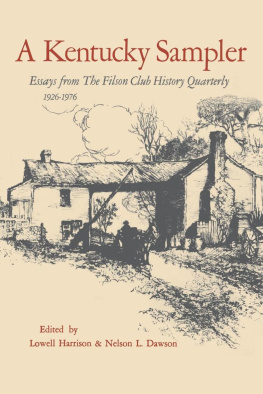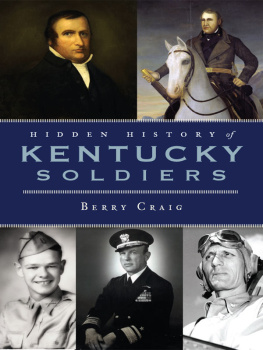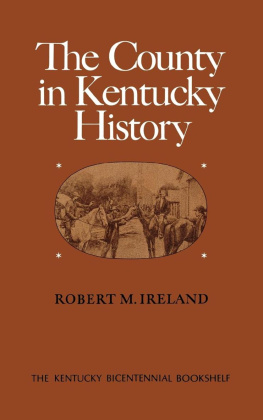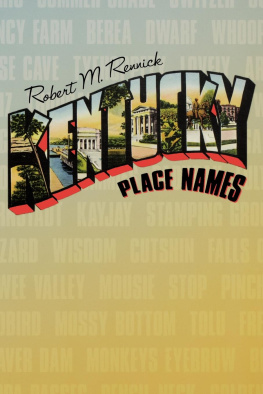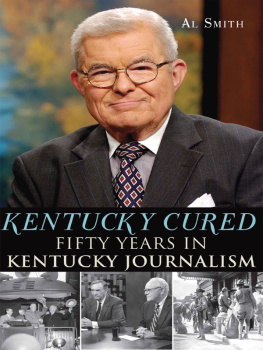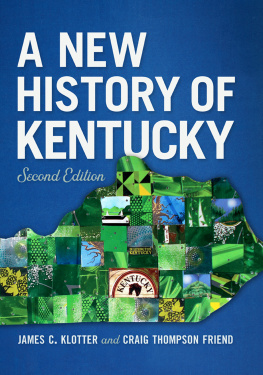ISBN: 978-0-8131-5258-5
Library of Congress Catalog Card Number: 77-76471
Copyright 1977 by The University Press of Kentucky
A statewide cooperative scholarly publishing agency
serving Berea College, Centre College of Kentucky,
Eastern Kentucky University, The Filson Club,
Georgetown College, Kentucky Historical Society,
Kentucky State University, Morehead State University,
Murray State University, Northern Kentucky University,
Transylvania University, University of Kentucky,
University of Louisville, and Western Kentucky University.
Editorial and Sales Offices: Lexington, Kentucky 40506
A SHORT HISTORY
OF THE FILSON CLUB
Many people do not consider anything worthy of historic interest until it acquires the patina of age. We are delighted with objects our ancestors lightly discarded, while we casually dispose of materials that will some day be of great interest to our descendants. Although Louisville was founded in 1778, a century passed before a permanent historical society was established.
In March 1880 Richard H. Collins, son of the Kentucky historian Lewis Collins, wrote Louisville businessman C. P. Moorman pointing out the need for a historical society in Louisville. He suggested that Moorman might be willing to provide a building and an endowment for so worthy a cause. The institution could, he observed, be called the C. P. Moorman Historical Society of Louisville. Moormans reply, while not extant, was apparently negative. Yet the idea had been expressed and interest demonstrated, and it did not die. On May 1, 1880, Reuben T. Durrett, Louisville lawyer, collector, and historian, read a paper before the Southern Historical Society to celebrate the one-hundredth anniversary of the founding of Louisville. In July, 1883, Durrett and several companions conducted a tour of historic sites in Jefferson County.
This interest led to the organization of a historical society in Louisville on May 15, 1884. Formed at Durretts home at 202 East Chestnut Street by ten interested Louisvillians, including Richard H. Collins, it was named The Filson Club in honor of John Filson who wrote the first history of Kentucky in 1784. Durrett was elected the first president, serving in that capacity until 1913. When The Filson Club was incorporated on October 6, 1891, its purpose was described as the collection and preservation and publication of historic matter pertaining to the State of Kentucky and adjacent states.
From its beginning the club drew high praise from many sources. Theodore Roosevelt, who consulted the clubs collections in preparation for his famous frontier history The Winning of the West, acknowledged his debt by writing: For original matter connected with Kentucky, I am greatly indebted to Col. Reuben T. Durrett, of Louisville, the founder of The Filson Club, which has done such admirable historical work of late years. In addition to collecting and preserving materials, The Filson Club also began publishing during the first year of its existence. The first series of publications consisted of thirty-six volumes appearing between 1884 and 1938. Soft-cover monographs with an average length of 260 pages, they have been widely consulted by students of Kentucky history. In 1926 the clubs publishing program was expanded to include the publication of a history journal called The Filson Club History Quarterly.
From 1884 to 1913 club meetings were held at Durretts home which served as the clubs headquarters until his death in 1913. In 1885 the time of meetings was fixed as the first Monday night of each month from October through June. After Durretts death the meetings were transferred to the Louisville Free Public Library. James S. Pirtle, a Louisville lawyer, became president in 1913 and served until 1917. He was succeeded by his brother Alfred Pirtle, a Louisville businessman, Civil War veteran, and important local historian, who was president until 1923.
In the early years The Filson Club made several unsuccessful efforts to secure a fireproof building to house its growing collection. R. C. Ballard Thruston, who became a club vice president in 1913 and president in 1923, continued these efforts. Born in 1858 with a distinguished Kentucky ancestry, Thruston was well qualified to lead The Filson Club. He studied at the Sheffield Scientific School of Yale University where he received a Bachelor of Philosophy degree in 1880. In 1882 Thruston began work for the Kentucky State Geological Survey. He left the survey in 1887 and entered private business. After a successful career, he devoted his time, interest, and financial resources to The Filson Club.
Thruston transferred the clubs possessions to his own office in the Columbia Building at Fourth and Main streets. In 1919 he promised the club his personal library and an endowment fund of $50,000 if a building with at least one fireproof room could be acquired. A fund drive in 1926 enabled the club to purchase property and convert two residences into a fireproof building. The Filson Club moved into its present home at 118 West Breckinridge Street in June 1929.
Thruston exceeded his original pledge, for in addition to the endowment fund, he gave another $50,000 as an emergency fund. Anticipating a new era of growth, the club amended the Constitution and By-Laws and Articles of Incorporation in May 1929. These amendments reorganized the club, established an endowment fund, and created endowment and life memberships. In 1935 another gift from Thruston established the Historical Acquisition Fund for the purchase of books, manuscripts, and other historical material.
The Filson Club celebrated its fiftieth anniversary in 1934 with a garden party held on May 12the Sunday nearest to May 15. The party proved a popular innovation and is now firmly established as an annual tradition. In 1934 the club had ten endowment, fifty-three life, and 486 annual members. The library had also grown. Thruston had given the club 5,467 books and pamphlets; Otto Rothert, longtime club secretary, had added another 926. With these gifts as a nucleus, the library consisted of over 10,000 items in 1934. The club also possessed a significant manuscript collection.
Although the rate of growth slowed during the depression and war years, the club was able to maintain itself during this difficult period. Book publication continued until 1938 when the last volume of the first series appeared. The membership increased from 526 in 1936 to 803 in 1946. By 1946 it had become apparent that the clubs library and museum holdings had expanded to the point where additional space would soon become necessary.
Thrustons long tenure as president of The Filson Club ended with his death in December 1946. He was succeeded by his good friend and great admirer J. Adger Stewart who worked to increase the clubs membership, establish improved administrative techniques, and expand stack and office space. Although Stewart retired after three years on the advice of his physician, he continued until his death in 1954 to work closely with Judge Davis W. Edwards who followed him as president. A building program, planned by Stewart, doubled the stack and office space. This expansion, completed in 1955, greatly improved the efficiency of the clubs daily operation.
Edwards guided the club ably until his death in 1962. During his tenure as president, the club celebrated its seventy-fifth anniversary in 1959. By this time membership had risen to over 1,500. Edwards was succeeded by Leo T. Wolford, a prominent Louisville attorney, whose tenure lasted until his death in 1971. These were years of steady growth for The Filson Club as the membership, endowment, library, and manuscript holdings continued to increase. A second series of book publications was begun in 1964.

